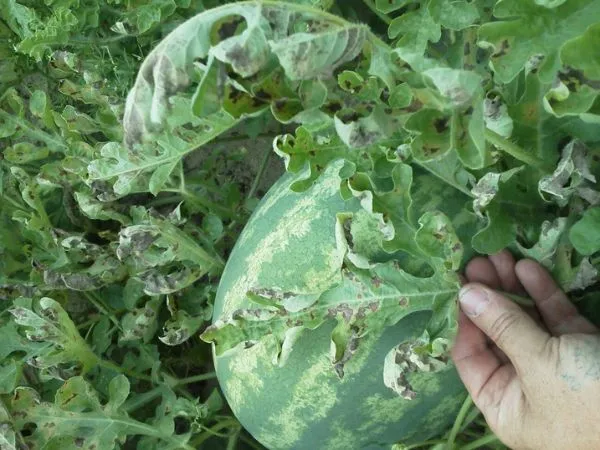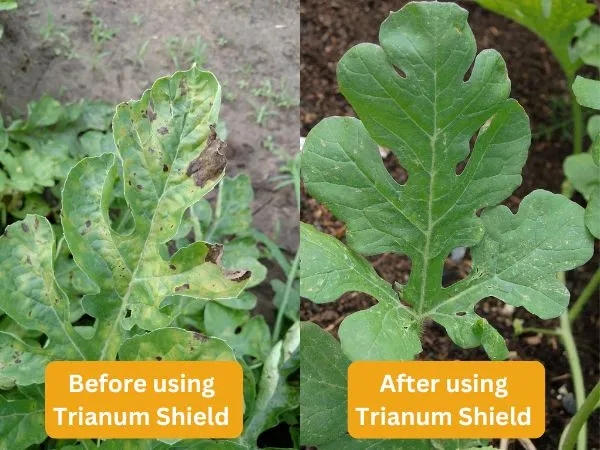Powdery Mildew Watermelon is a type of fungal attack that has a reputation for being resistant to fungicides. It is a very dangerous fungus PODOSPHAERA XANTHII, and is a very common illness that usually affects fruits like watermelon.

Powdery mildew watermelon is usually caused by fungi but are influenced by many factors like:
When considering the impact of powdery Mildew on watermelon plants, the presence of powdery leaves is quite dangerous for this plant as it shows a sign of fungal infection.
It can impact the total crops of watermelon and other plants very easily. If you see this sign, then you have to be really alerted at any cost. Watermelon powdery mildew is dangerous, just like other powdery mildew diseases.
Prevention is higher than cure, however if it’s miles approximately therapy already, then doing it as quick as feasible is crucial too. Checking your garden constantly and catching the signs of powdery Mildew watermelon leaves so that you can treat them quickly.
Maintaining a good garden is like maintaining good health, so regular check-up is what everyone suggests. If you are curious about how to treat powdery Mildew on watermelon leaves, then this article is just for you.
Are you worried thinking how to treat powdery mildew on watermelon? Before that you should know, it is also common in other cucurbits like pumpkins, squash, and cucumber. With powdery growth on the leaves surface, shoots, fruits, flowers, and buds, this disease attacks all parts of the plants.
Understanding the conditions that promote powdery mildew infection is quite necessary if you are looking to tackle it. The basic symptoms might differ, but there are a few common ones that you should mark. These are usually the colonies of fungus, and they do not attack in small patches.
These dangerous fungus PODOSPHAERA XANTHII usually prefer to first attack the leaves, and that is where you should usually focus. After attacking leaves, they usually go all out against the fruits.
You will find white powdery spots coming up as they start the infestation and sometimes even yellow spots. Leaf curling and yellowing is something where you need to catch up and be highly alert. Slowly, you will find reduced fruit quality being a sign. These are some of the basic symptoms mostly of powdery mildew watermelon diseases.
Conditions should be usually checked to be protective against powdery mildew. High, humid conditions and moderate temperatures are usually quite suitable for such fungal attacks, and that is when you should know that you should bring powdery mildew fungicide for melon.
It is quite necessary to keep an eye on these minute things, or else you will lose the essence of your lovely garden more often than not. Humid conditions and moderate temperatures are known to create moist weather, and that is when powdery Mildew disease of watermelon happens.
It is quite dangerous, and that is why ethical practice is always necessary. Always keep the points given above in mind to tackle powdery mildew.
Resistant varieties are not usually found in watermelon. It needs proper research to check if, in future, you can go for finding mildew-resistant watermelon varieties.
You need to have at least highly resistant varieties, even if you do not find completely resistant varieties. Protecting your garden from watermelon powdery mildew is necessary, and that is where finding resistant varieties comes into play.
Crop rotation plays a vital part in every garden. So, always make sure you are not consistently planting watermelons. Prefer to check the soil quality before going for the plantation.
Crop rotation is always something that ensures that the soil is not infested, but if it is infested, then avoid it. Rather than going for watermelon powdery mildew treatment, it is better to prevent it from the start. Watermelon powdery mildew fungicide can be a blessing for a farmer.
Organic methods to treat powdery Mildew on watermelon are always the best option. If you are someone who loves to go for long safety of crops and soil, then the organic method is something that you can prefer.
When we talk about organic treatment, we cannot miss out on neem oil usually. It is known to control watermelon powdery Mildew and many other diseases that regularly happen in crops. Prefer to spray 2.5 tablespoons. The frequency should be mostly 7 to 14 days. You can also use mint oil or rosemary oil, which are nowadays popular for controlling powdery Mildew on watermelons.
Do you have any troubles? Well, baking soda is, more often than not, the best home remedy. Even for treating powdery mildew on watermelons, baking soda is usually quite effective. Usually, you should prefer to mix one tablespoon of baking soda with approximately half a teaspoon of liquid type of soap in mostly 1 gallon of water.
Prefer to have the mix in a spray bottle and spray on the undersides and the top of the leaves and every other affected area to prevent or cure the future or existing powdery mildew infection of the watermelon plants. It is a very simple and effective method.
Milk spray is another fantastic way to tackle powdery Mildew on watermelons. It is usually made with 40 percent milk and 60 percent water. It is a very popular home remedy that works in many plants. If you are looking for the best results, then spray on the plants every 10 to 14 days.
Are you worried about how to treat powdery Mildew on watermelon? Chemical treatments are always quick-fix options, but nowadays, with Novobac entering the market, it has focused on having chemical treatment products that are always safe for sustainable agricultural practices.

Trianum Shield is a product that not only provides resistance to powdery Mildew on watermelon but also improves the quality of soil by increasing its nutrients. It is the best powdery mildew fungicide for watermelon. With good quality soil, this product also ensures the proper root growth of the plants. Novobac has always been a reliable manufacturer of sustainable agricultural products.
Trichoderma Harzianum is the active product of Trianum Shield and has always been the flag bearer in attacking powdery Mildew by creating a shield of protection. This product has been a product that has made Novobac sure that it can play a vital role in sustainable agricultural practices quite easily.
While applying Trichoderma Harzianum, always be sure to apply this fungicide 1.5 kg to 3kg per acre as soon as possible. Always prefer to reapply this fungicide with a gap of 10 to 12 weeks. You can do drill fertilization, broadcast application, and root irrigation to apply this powdery mildew fungicide for watermelon.

Clean spraying is always preferred if you are thinking of this disease’s treatment. Adding a solution to the spray or tank can always help you treat it.
Being vigilant and proactive is always good for the plantation as it results in good results without making the crops suffer from any disease. Protecting watermelon crops from the disease can always ensure good fruits and good health for the lovers of watermelon.
Cutworms in gardens are a major menace to all..
As a farmer,I inspect my fields daily to monitor..
It all started with a worried farmer named Mr...

Leave a Reply